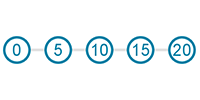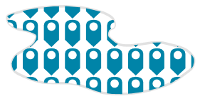Marker symbol layers are most commonly used in point symbols, usually placed directly on the point feature geometry. You can adjust the anchor points and offsets of a marker to customize their relative position. Marker symbol layers are also used in line and polygon symbols, drawn along lines and outlines, at endpoints, or within polygon interiors.
Marker placements
When a marker symbol layer is included in a line or polygon symbol, it includes a marker placement, which determines how and where the symbol positions the markers relative to the feature geometry. Marker symbol layers in a point symbol do not have a marker placement; they are always placed relative to the point geometry. There are a number of marker placements to choose from. Most are valid in both line and polygon symbols, but some are valid in one geometry type only.
- With a line or polygon symbol selected, open the Format Symbol pane and click the Properties tab.
- Add a marker symbol layer to the symbol if necessary.
- Click the Layers tab
 . Highlight a marker symbol layer and expand the Marker Placement heading.
. Highlight a marker symbol layer and expand the Marker Placement heading. - Specify a Placement as described in the table below. Use the symbol preview to validate the settings.
| Marker Placement | Description | Example |
|---|---|---|
Along line
| Markers are evenly spaced along the line or polygon outline according to the Placement template, which can be a single number or a series of numbers. A placement template of 10 places a marker every 10 points (or other unit as defined by the 2D symbol display unit). A placement template of 10 2 places a marker at 10 points along the line, another one 2 points farther, another one 10 points farther than that, and so on. Check Angle to line to orient the markers to the line instead of pointing up. Set Perpendicular offset to place markers away from the line. Decide whether the Endings draw with a marker or a gap, or no constraint. Set Endings to With half gap for a seamless progression from one connecting line to another. When Endings is set to Custom, you can set Custom offset to adjust how markers fall in relation to the end of the line. Set an Offset value to push all markers along the line. | 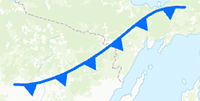 |
Along line with random size
| Markers are evenly spaced along the line or polygon outline according to the Placement template selection, but the size and placement orientation is randomized, as specified by the Randomization property. Offsets and endings are set the same way as with the Along line placement. |  |
Along line with variable size
| Markers are evenly spaced along the line or polygon outline according to the Placement template selection, but the size varies progressively, as specified by the Minimum zoom, Maximum zoom, Size count, and Method properties. Orientation is not randomized. The markers are always oriented to the line, but you can randomize the offset off the line with the Maximum random offset property. Endings are set the same way as with the Along line placement. Use the Place per part property to determine how markers are placed on multipart features. | 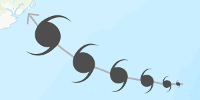 |
Around polygon | A single marker is placed around the polygon at the location specified by the Position property. Use the Offset from edge property to move the marker in or out of the polygon. Use the Place per part property to determine how markers are placed on multipart features. | 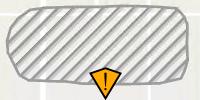 |
At extremities
| Markers are placed at the ends of the line as specified by the Extremities property. Choose from Both, At begin, At end, or None. Orientation and offsets are set the same way as with the Along line placement. This placement is available in line symbols only. Use the Place per part property to determine how markers are placed on multipart features. | 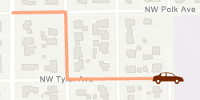 |
On line
| A single marker is placed at the beginning, middle, or end of the line, or one marker is placed at the midpoint of every line segment, as specified by the Relative to property. Orientation is set the same way as with the Along line placement, and you can specify a Perpendicular offset value and an Offset value along the line. Use the Place per part property to determine how markers are placed on multipart features. | 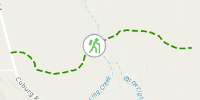 |
On vertices
| A single marker is placed on the vertices of the line or outline, according to the On regular vertices property. Marker can be positioned with Angle to line and can have a Perpendicular offset value placing them away from the line or outline. Markers can optionally be placed with the On extremities setting (start and end points), and with the On control points setting. You can add control points with a symbol effect. Use the Place per part property to determine how markers are placed on multipart features. | 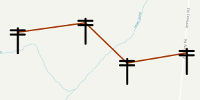 |
At ratio positions
| Markers are placed proportionally along the length of the line or outline by specifying ratios of the total line length in the Positions property. You can customize the positions by specifying values forBegin position, End position, and Perpendicular offset. Use the Flip first property marker to have the markers at the ends point in separate directions. Use the Place per part property to determine how markers are placed on multipart features. | 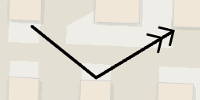 |
At measured units
| A single marker is placed along a line at a set Interval value according to m-values on the feature. The associated marker can include a text element which is connected to the m-value attribute. The marker can be positioned with the Angle to line setting and can have a Perpendicular offset value placing them away from the line or outline. Markers can optionally be placed with the On extremities setting (start and end points). Specify a Skip marker rate value to suppress markers at certain intervals. This is helpful when two or more levels of interval are being shown in conjunction. Use the Place per part property to determine how markers are placed on multipart features. See Draw measured hatches along lines for detailed instructions. | 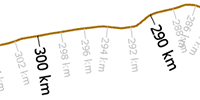 |
At center
| A single marker is placed within the polygon, with the On polygon, Center of mass, or Bounding box center setting as specified by the Method property. You can specify offsets in x and y, and clip the marker to the polygon boundary if it exceeds the size or otherwise overlaps the polygon outline. This placement is available in polygon symbols only. Use the Place per part property to determine how markers are placed on multipart features. |  |
Fill polygon
| Markers are placed within the polygon, either with the Fixed grid or Random setting, as specified by the Position property. Adjust the spacing of the markers with the X Step and Y Step properties. When Fixed is selected, specify a Grid angle. When Random is selected, specify the Randomness value. If two marker layers are drawn together, specify different values for Seed Values to ensure different random placements. Identical seed values place randomly placed markers from two marker symbol layers in identical spots. You can specify offsets in x and y, and clip the markers to the polygon boundary if they overlap the polygon outline. This placement is available in polygon symbols only. | 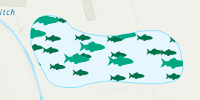 |
Anchor points
The anchor point is the location in the marker symbol layer that shows where it draws relative to feature geometry. When you rotate or resize a marker symbol layer, the transformation originates from the anchor point. You can set common anchor point positions by clicking Anchor point presets and choosing a location from the gallery. This is a shortcut to configure the X, Y, and Z anchor points. (In 2D, you work with just X and Y anchor points.) You can further refine these settings after you choose a preset as a starting point. Anchor points can be specified as a relative percentage of the marker symbol layer's extent or as an absolute distance.
- In the Format Symbol pane, on the Properties tab, click the Layers tab
 .
. - Highlight a marker symbol layer and expand the Postition heading.
- Expand the Anchor point presets menu and choose a preset collection of anchor point values.
- Optionally, refine the X, Y, and Z (in 3D only) anchor point values further. Use the symbol preview to validate the settings.
Note:
When a marker layer is billboarded in a 3D context, only anchor points in two dimensions—X and Y—are available. When a shape or picture marker layer has Depth of 0 and the anchor points are specified by a Relative percentage, the Z anchor point is disabled because there is no z-thickness in which to adjust anchor point placement.
Offsets
Offsets are linear translations that are applied to the marker symbol layer from the origin of the anchor point after all other transformations have taken place.
- In the Format Symbol pane, on the Properties tab, click the Layers tab
 .
. - Highlight a marker symbol layer and expand the Offset Distance heading.
- Specify values for Offset X, Offset Y, or Offset Z (in 3D only). Use the symbol preview to validate the settings.
Legacy:
When you import a map or scene from ArcMap, ArcScene, or ArcGlobe, or by importing a style, existing symbol offset values are converted to anchor points. Values may not be exactly equal to account for rotation differences.








